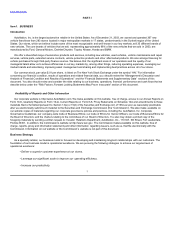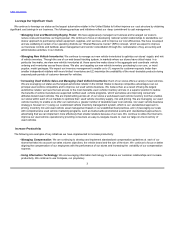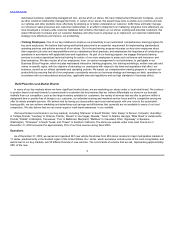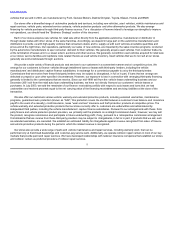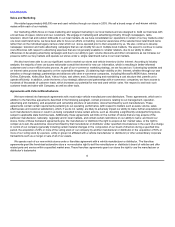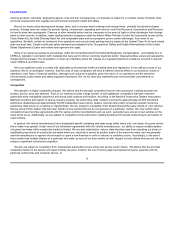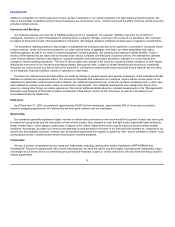AutoNation 2003 Annual Report Download - page 13
Download and view the complete annual report
Please find page 13 of the 2003 AutoNation annual report below. You can navigate through the pages in the report by either clicking on the pages listed below, or by using the keyword search tool below to find specific information within the annual report.
Table of Contents
Risk Factors; Forward-Looking Statements May Prove Inaccurate
Our business, financial condition, results of operations, cash flows and prospects, and the prevailing market price and performance of our
common stock, may be adversely affected by a number of factors, including the matters discussed below. Certain statements and
information set forth in this Annual Report on Form 10-K, as well as other written or oral statements made from time to time by us or by our
authorized officers on our behalf, constitute “forward-looking statements” within the meaning of the Federal Private Securities Litigation
Reform Act of 1995. We intend for our forward-looking statements to be covered by the safe harbor provisions for forward-looking statements
contained in the Private Securities Litigation Reform Act of 1995, and we set forth this statement and these risk factors in order to comply
with such safe harbor provisions. You should note that our forward-looking statements speak only as of the date of this Annual Report on
Form 10-K or when made and we undertake no duty or obligation to update or revise our forward-looking statements, whether as a result of
new information, future events or otherwise. Although we believe that the expectations, plans, intentions and projections reflected in our
forward-looking statements are reasonable, such statements are subject to known and unknown risks, uncertainties and other factors that
may cause our actual results, performance or achievements to be materially different from any future results, performance or achievements
expressed or implied by the forward-looking statements. The risks, uncertainties and other factors that our stockholders and prospective
investors should consider include, but are not limited to, the following:
The automotive retailing industry is cyclical and is sensitive to changing economic conditions and various other factors. Our
business and results of operations are dependent in large part on new vehicle sales levels in the United States and in our
particular geographic markets and the level of gross profit margins that we can achieve on our sales of new vehicles, all of
which are very difficult to predict.
The automotive retailing industry historically has been subject to substantial cyclical variation characterized by periods of oversupply of
new vehicles and weak consumer demand. We believe that many factors affect industry-wide sales of new vehicles and retailers’ gross profit
margins, including consumer confidence in the economy, the level of manufacturers’ excess production capacity, manufacturer incentives
(and consumers’ reaction to such offers), intense industry competition, interest rates, the prospects of war, other international conflicts or
terrorist attacks, the level of personal discretionary spending, product quality, affordability and innovation, fuel prices, credit availability,
unemployment rates, the number of consumers whose vehicle leases are expiring, and the length of consumer loans on existing vehicles.
Significant increases in interest rates, in particular, could significantly impact industry new vehicle sales due to the direct relationship
between higher rates and higher monthly loan payments, a critical factor for many vehicle buyers. The length of consumer auto loans has
increased recently and leasing of vehicles has decreased, which may result in customers deferring vehicle purchases in the future. We
experienced downward pressure on our new vehicle gross profit margins during 2003, which we believe was largely due to manufacturers’
excess production capacity and increased competition in the industry. Our new vehicle sales may differ from industry sales, including due to
particular economic conditions and other factors in the geographic markets in which we operate. A significant decrease in new vehicle sales
levels in the United States (or in our particular geographic markets) during 2004 as compared to 2003, or a further decrease in new vehicle
gross profit margins, could cause our actual earnings results to differ materially from our prior and projected earnings results. Economic
conditions and the other factors described above also may materially adversely impact our sales of used vehicles, finance and vehicle
protection products, vehicle service and parts and repair services.
We are subject to restrictions imposed by, and significant influence from, vehicle manufacturers that may adversely impact
our business, financial condition, results of operations, cash flows and prospects, including our ability to acquire additional
stores.
The major vehicle manufacturers have significant influence over the operations of our stores, including due to the terms and conditions of
our framework, franchise and related agreements, and the manufacturers’ interests and objectives may, in certain circumstances, conflict
with our interests and objectives. For example, manufacturers can set performance standards with respect to sales volume, sales
effectiveness and customer
11


